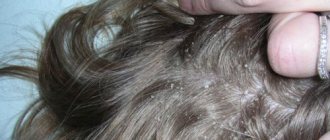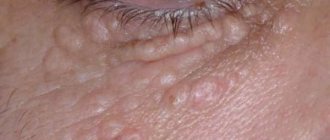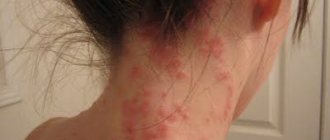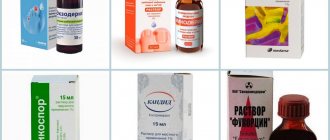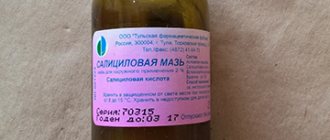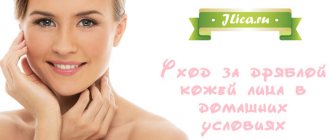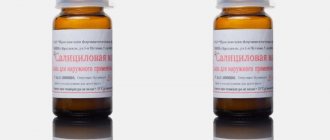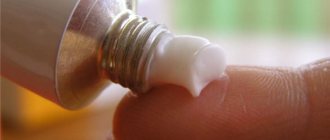Compound
Sulfur ointment is a viscous substance of yellow or light yellow color. The drug consists of sulfur itself and auxiliary components in the form of a mixture:
- soft white paraffin,
- purified water,
- emulsifier T-2.
Soft white paraffin, also known as Vaseline, included in the composition, enhances the healing effect due to its own softening and protective properties. The ointment appears to be homogeneous in composition; small grains are felt to the touch. The concentration of the active substance is 5, 10, 20 or 33% depending on the release form. It goes on sale in dark glass jars or tubes of 25, 30, 40 grams and is sold without a doctor's prescription.
Simple sulfur-based ointment is available in two types: 10% and 33%.
The therapeutic effect is achieved due to the properties of the active substance (precipitated sulfur).
For better absorption of the active compound by the tissues and cells of the epidermis, a consistent emulsion consisting of petroleum jelly and water is also used in production.
Product description: medium density substance, light yellow color, specific smell.
Pharmaceutical companies produce analogues that have a combined composition.
In addition to sulfur, it contains:
- salicylic acid (main purpose – psoriasis, seborrhea);
- birch tar (main purpose – scabies).
Popular ointments to combat dandruff
Based on the listed active substances, some of the most effective drugs for seborrheic dermatitis have been created.
It is not recommended to use the products without consulting a doctor - if used uncontrolled, they can cause irreparable harm to health and aggravate the problem. Consider popular ointments that are intended for the treatment of seborrheic dermatitis.
Non-hormonal drugs
Tsindol
Ingredients: zinc oxide, talc, potato starch, glycerin, ethyl alcohol, water.
Contraindications: individual intolerance to the components.
Bepanten
Ingredients: dexpanthenol, protegin X, cetyl and stearyl alcohol, white beeswax, lanolin, soft white paraffin, almond oil, liquid paraffin, water.
Contraindications: individual intolerance to the components.
Simple sulfur ointment
Ingredients: precipitated sulfur, T-2 emulsifier, white petroleum jelly, water.
Contraindications:
- individual intolerance to components;
- children under 3 years old.
Naftaderm
Ingredients: refined naftalan oil, emulsion wax, ethyl alcohol, water.
Contraindications:
- hypersensitivity;
- severe anemia;
- renal failure;
- hemorrhagic syndrome.
Clotrimazole
Ingredients: clotrimazole, propylene glycol, polyethylene oxide, polyethylene oxide, methylparaben.
Contraindications:
- individual intolerance to components;
- pregnancy (1st trimester).
Use with caution during lactation.
Hormonal drugs
Belosalik
Ingredients: betamethasone dipropionate, salicylic acid, mineral oil, petroleum jelly.
Contraindications:
- rosacea and rosacea-like dermatitis;
- skin tumors (sebaceous cyst, sarcoma, epithelioma, hemangioma, xanthoma, melanoma, cancer);
- varicose trophic ulcers;
- post-vaccination reactions on the skin;
- hypersensitivity;
- pregnancy and lactation;
- skin diseases (viral, fungal and bacterial);
- children under 1 year.
Use with caution:
- long-term therapy (in particular, with the use of occlusive dressings);
- children from 1 year;
- liver failure.
Triderm
Ingredients: betamethasone dipropionate, clotrimazole, gentamicin, liquid paraffin, soft white paraffin.
Contraindications:
- individual intolerance to components;
- post-vaccination reactions on the skin;
- skin tuberculosis, syphilis, chicken pox, herpes;
- open wounds;
- children under 2 years old.
Use with caution:
- long-term therapy (in particular, with the use of occlusive dressings);
- large affected area;
- injured skin;
- pregnancy (1st trimester);
- children from 2 years old.
Pimafukort
Ingredients: pimaricin, neomycin, micronized hydrocortisone, liquid paraffin, polyethylene.
Contraindications:
- individual intolerance to components;
- skin tumors;
- acne, rosacea, ulcers, open wounds, ichthyosis;
- skin reactions from vaccines;
- syphilis, tuberculosis and viral skin lesions.
Sulfur-salicylic ointment
The composition of the ointment with salicylic contains significantly less sulfur than simple sulfur ointment. It contains only 2g 100g base (2%). In addition to sulfur, the ointment also contains 2 g of salicylic acid. It significantly enhances the antibacterial and antiseptic effect. It also regulates the secretion of sebum, which provides a drying effect.
In addition, salicylic acid penetrates deeply into the skin and causes increased blood circulation. What accelerates tissue regeneration.
Sulfur-salicylic ointment cleanses pores and dries out inflammation. However, the composition with salicylic acid is irritating. Therefore, it is used for oily skin and not for dry skin. For dry skin, a simple one-component ointment with sulfur is better suited.
Salicylic acid is often used to treat acne. It can cause a burn (if applied as a compress) or dry out the skin too much (if you frequently wipe your face with acid or alcohol). Therefore, they began to use salicyl in a complex manner, adding it to preparations along with other components.
The list of diseases for which sulfur-salicylic ointment is used includes juvenile acne, ringworm, mites under the skin and demodicosis.
Now let’s look at what sulfur ointment helps people with.
Diet for dry seborrhea
The patient is almost always recommended a special diet. Proper nutrition makes the immune system stronger, digestion better, and as we already know, these factors are very important for successful treatment. The emphasis when creating a menu for a person with seborrheic dermatitis of the scalp is on anti-allergenic foods rich in vitamins. This can be fruits (apples, pears), porridge (buckwheat, pearl barley), poultry and fish, vegetables.
Prohibited for use during treatment:
- citrus;
- honey and all products to which it can be added;
- mushrooms and nuts;
- if you have lactose intolerance - dairy products.
Also, with dry seborrhea, it is highly not recommended to eat large amounts of carbohydrates and fatty foods. This food, on the contrary, worsens the condition of the skin, in addition, it can slow down the healing process. Well, of course you should refrain from alcoholic beverages.
Sulfur ointment for parasitic mites: scabies
Scabies is a parasitic disease in which a microscopic insect, a mite, settles on human skin. The main unpleasant symptom of the disease is severe itching, which accompanies the appearance of parasites. In addition to itching, a small pustular rash appears.
Scabies is transmitted through close contact. To become infected with this parasite, prolonged “body-to-body” contact is required. Therefore, many modern doctors consider scabies a sexually transmitted infection.
Treating scabies with sulfur ointment was popular fifty years ago. Sulfur treatment is still prescribed in post-Soviet countries. European medicine uses other, more aggressive means.
In order to remove ticks with sulfur ointment, in the evening before bed it is applied to the entire surface of the body. For children, the ointment is even rubbed into the face and under the hair.
After sulfur ointment, you should not wash for 24 hours. Afterwards, if necessary, you can take a shower, dry the skin and reapply the ointment.
The choice of concentration of sulfur ointment for scabies is determined by age. For children it is recommended to use a 10% composition, for adults - 20% sulfur ointment. The duration of treatment is a minimum of 3 days – a maximum of 7-8 days. After a week, the person is considered cured.
Sulfur ointment and demodicosis
In addition to the well-known scabies mite, a person’s skin can become infected with another mite-borne parasite - the glandular acne. This microscopic insect settles in the ducts of the sebaceous glands and hair follicles. The ironweed prefers the skin of the face, settling on the forehead, chin, nasolabial folds, eyelids and in the outer part of the ear canals.
Infection with this parasite occurs unnoticed. Its appearance is accompanied by the sudden development of large pink pimples on the face. The skin infection becomes chronic and periodically worsens (during the off-season - spring, autumn).
Ironworm infection is called demodicosis. The use of sulfur ointment for demodicosis consists of applying it to the face twice a day (morning and evening). Treatment periods are long, from one to three months.
Types of dermatitis, their symptoms and methods of treatment
First of all, dermatitis is divided into local and general (diffuse) according to the degree of distribution throughout the body. In the first case, the disease covers only one area, and in the second, it spreads to different areas.
There is also a chronic or acute course of the disease. With chronic dermatitis, skin inflammation lasts a long time or gradually appears, and then spreads, covering other healthy areas of the skin. And with acute dermatitis, the disease appears suddenly and immediately with all sorts of symptoms.
It is important to determine the type of disease, since the correct choice of treatment and ointment for dermatitis depends on this.
Seborrheic dermatitis
Seborrheic dermatitis is also called seborrhea or seborrheic eczema. Its causative agent is Malassezia fungi, which are located near the sebaceous glands.
Normally, any person has these fungi, but when there are problems in the body, their number increases and, therefore, they secrete more enzymes, products of their vital activity, which irritate human skin, causing inflammation, peeling and itching.
Since fungi are concentrated near the sebaceous glands, seborrhea usually occurs in places where there are many of these glands: the face, scalp, upper back, abdomen, sternum, folds (armpits, under the breasts in women).
Seborrhea looks like inflammation with characteristic skin flakes. But in the head such layers can be especially large and look like white flakes. Often accompanied by itching.
The reason for the failure of the natural level of such fungi in the skin microflora is usually weakened immunity, stress, diseases of the endocrine system and much more. Products with a high alkali content can also disrupt the balance of microflora. Seborrhea can have complications in the form of constant dandruff, baldness, conjunctivitis, and furunculosis.
Treatment should be carried out comprehensively: drink immunostimulants, use antifungal ointments for dermatitis and antiseptic antifungal agents, adhere to a diet rich in zinc and vitamins.
Atopic dermatitis
This type of dermatitis is a manifestation of an allergy, an immune reaction to allergens, which, as a rule, appears very quickly (within a few minutes) in the form of redness with itching. Sometimes there is blistering.
An allergen is usually some food component. Atopic dermatitis often occurs in young children as a reaction to inappropriate foods. Very often, allergies are hereditary.
It is treated with ointments with zinc, sorbents and other anti-allergenic and antihistamine drugs, as well as dietary adjustments.
Contact dermatitis
Contact dermatitis is a reaction to the skin immediately after contact with an irritant. It may be a substance to which a person is hypersensitive.
Contact dermatitis often occurs in people after cleaning the house with chemicals without gloves, after touching a poisonous plant, alkaline products, after dyeing hair without gloves, or from exposure to low temperatures.
The manifestation is in many ways similar to allergic and atopic dermatitis: redness, itching, peeling, and in severe cases, blisters.
Allergic dermatitis
Allergic dermatitis differs from contact dermatitis in that it occurs after contact with an allergen. Silver or nickel jewelry, latex, certain clothing materials, medications, and much more can act as an allergic irritant.
Characteristic manifestation: redness of the skin with a feeling of roughness, abrasion, sometimes itching or blisters in advanced cases.
Perioral dermatitis
Perioral dermatitis is so called, first of all, because of its location: near the mouth. It usually appears in women after using cosmetics with corticosteroids. Also among the reasons are: the presence of bacterial or fungal lesions on the skin, external conditions (high humidity, frost), disruptions of the hormonal system.
Perioral dermatitis differs in appearance from the above types. It is characterized by rashes consisting of a bunch of small pimples, which can form what appears to be one large spot. Usually accompanied by itching and a burning sensation. This type of dermatitis is treated with ointments.
Venous (varicose) dermatitis
This type of dermatitis occurs when there are problems with the veins: varicose veins, damage, and less often - infectious lesions, diabetes mellitus, vein thrombosis. It occurs mainly in older people.
It appears on the legs in the form of inflamed areas of a reddish-violet, brown color, sometimes blisters appear. There is very severe itching, swelling, wetting and crusting on the legs. It is usually treated by eliminating the symptoms of varicose veins, sometimes surgical intervention is required.
Diaper dermatitis in children
The diaper type of the disease occurs in children who wear diapers. Mainly around 6 months because the baby starts to move and his skin starts to rub against the diaper. It looks like redness with slight peeling near the baby's genitals. Often diaper dermatitis occurs together with atopic or seborrhea with corresponding causes.
Parents need to maintain baby hygiene and change the diaper as often as possible, use creams and oils.
Ear dermatitis
The place of manifestation of ear dermatitis is, accordingly, the ears. The cause is violations of hygiene rules or a reaction to cosmetics, wearing earrings, headphones, internal processes occurring in the ear and much more. The disease can be located inside the auricle and canal. Treated with ointments, antibiotics, and diet adjustments.
Inguinal dermatitis
The inguinal type of the disease occurs in both women and men. Inguinal dermatitis itself is in turn divided into types:
- dermatophytic and candida types caused by fungi,
- psoriasis chronic,
- sulfur type,
- erythrasma caused by bacteria.
Reasons may include:
- kidney problems,
- parasites,
- fungi/bacteria,
- violation of hygiene,
- profuse sweating.
Depending on the type, ointments for dermatitis are prescribed. You should also remember about personal hygiene and, if possible, avoid staying in places where it is very easy to catch the disease: public baths, saunas, toilets.
Eyelid dermatitis
Another type of disease, determined by its location. Eyelid dermatitis occurs on the eyelids and is usually caused by: fungi, bacteria, allergies, insect bites, immune and nutritional problems. Occurs with the dermatitis already mentioned above: gray, allergic, atopic, etc.
Characteristic symptoms in the form of hardening, swelling and redness of the skin with scales and itching can also include manifestations of the disease in the eye itself: pain, lacrimation, pain in the eyes, redness of the eyeball.
Pruritic dermatitis
This is a collective name for all types of dermatitis if they are accompanied by itching. Itching usually occurs with seborrhea, contact, atopic and allergic types.
Characteristic symptoms: redness and inflammation, depending on the type, and severe itching.
Dry dermatitis
If some types of the disease are accompanied by wetting (wetting dermatitis), then there is also a dry type of the disease, which occurs most often. It usually occurs in people with very dry skin.
Reasons: heredity, very dry skin, skin hypothermia, nutrition, lifestyle, stress, fungi, bacteria. There are characteristic redness, peeling, blisters and dry crust of skin scales.
Instructions for use
General recommendations for using a dermatological product:
- the affected areas are treated with medicine 2-3 times a day;
- The ointment should be applied exclusively to the focal area, the surface of healthy skin is affected only 1-1.5 cm at the edges;
- a thin layer of medicine is formed (it is rubbed in in a circular motion);
- The duration of therapy is determined by the attending physician (on average, the course lasts 3-10 days).
The method of treating lesions depends on the nature of the disease. For minor lesions, the ointment is applied once a day; the presence of large areas requires frequent procedures (up to 3 times a day).
Before carrying out the treatment procedure, the skin on which the pathological manifestations are located is washed with soap and dried with a towel.
The medicine is distributed only over dry skin.
For one-time processing, you should choose the evening time. Throughout the night, the active components will work in the outbreak, fighting the pathological process.
There is no need to rinse off the product before going to bed.
Scabies
To combat subcutaneous mites, ointment is used in a concentration of 10%. The skin of the entire body is subject to treatment.
The medicine should be applied for three days in a row (at night).
You should not take a bath or shower these days.
Clothes must be changed every time. Simple washing does not have an antiparasitic effect, so underwear is boiled or disinfected in another way.
With scabies, the mite most often affects the area between the fingers. After using the medicine, it is not recommended to wash your limbs for at least 3 hours.
Pediculosis
The medicine has a weak effect on lice, and practically no effect on nits.
But due to its safety, the ointment is recommended for children over 3 years of age.
Rules for using the ointment:
- before treatment, the medicine is diluted with water in a ratio of 1:1;
- using a cotton pad, apply to the scalp and the entire length of the strands;
- leave under a plastic cap for 30-40 minutes;
- wash off using shampoo and rinse with water and vinegar (the components are diluted in a 1:1 ratio).
Repeated procedures should be carried out after 3-4 days.
Dermatitis
The procedure schedule is 2 times a day.
Duration of therapy is 3-7 days. It is recommended to use 5% ointment.
Fungal infections
Focal areas of the body are treated 1-2 times a day.
For 5 days, taking a bath or shower is prohibited, but clothes will need to be changed daily.
At the end of the period, the remnants of the ointment are washed off and clean underwear is put on. All removed clothing must be disinfected.
Sulfur ointment owes its healing properties to sulfides and pentathionic acid, which are formed when sulfur reacts with organic substances in the skin. Thus, it has antimicrobial, antiparasitic and antifungal properties, as well as the ability to restore the affected areas of the upper layer of the skin - the epidermis.
The concentration of sulfur ointment is of great importance. With a low percentage of sulfur, it will promote the healing of small wounds and defects that have arisen on the affected skin and activate the formation of new cells. Quite quickly after the start of treatment, the inflamed areas stop itching.
The use of 33 percent sulfur ointment allows you to loosen the upper layers of the skin with subsequent removal of dead areas, for example, with seborrhea. This process is facilitated by irritation of skin receptors, which leads to improved blood supply to the treated areas. This speeds up metabolism in the epidermis and speeds up recovery.
The choice of concentration of the ointment, as well as the scheme of its use, depends on the specific skin disease, the severity of the disease and requires consultation with a specialist. With its help you can successfully treat:
- scabies,
- lichen,
- various dermatitis,
- seborrhea,
- eczema,
- psoriasis,
- demodicosis,
- fungus.
The term dermatitis combines a group of skin pathologies that manifest themselves in response to various irritants in the form of rashes, redness and itching. Such manifestations are usually based on an allergic reaction, therefore, using sulfur ointment, you can relieve irritation, reduce inflamed areas, and with a weeping form - reduce pain as a result of the drying effect. However, a disease can be completely cured only after its cause is eliminated.
Seborrheic dermatitis most often affects the scalp, although it can also appear on other areas of the skin. The disease is associated with increased secretion of the sebaceous glands. Severe peeling, accompanied by itching, leads to the formation of crusts, which can often be observed in newborns.
It should be remembered that the disease is not as simple as it seems. It is provoked by gastrointestinal problems, disorders of the nervous system, hormonal imbalance, and stress. Therefore, as with any other dermatitis, other strong drugs, including hormonal ones, will be needed for treatment.
Eczema is characterized by various skin lesions: from itchy, weeping blisters to profuse redness with dry cracks, accompanied by a burning sensation. Proceeding in an acute or chronic form, it has a cyclical nature, either subsiding after treatment or exacerbating again. Particular mental discomfort is caused by frequent damage to open areas.
Sulfur ointment for eczema creates a protective barrier against the penetration of pathogenic microorganisms through inflamed areas and can be used not only on the hands, but also on more delicate areas - the face and neck. In the weeping form, sulfur-zinc ointment has a powerful antiseptic effect.
There are many methods and special medications for the treatment of seborrhea, which, when properly prescribed, give remarkable results. One of the favorite forms of medications for seborrhea are all kinds of ointments. The popularity of such funds is explained by several factors:
- Disinfect the surface
- Suppresses the growth of various fungi
- Softens dry crusts, promoting their healing and elimination
- Activate the healing of the epidermis
- Accelerate the formation of new skin cells and, accordingly, renewal of the skin
- Cleans the surface of dandruff.
In addition to therapeutic effects, the advantage of ointments for seborrhea is their affordability and the availability of a variety of drugs in pharmacies: from the simplest to the latest developments.
The disadvantages of ointments include a specific, not always pleasant smell, difficulty in rinsing, as well as a long treatment period. But even with these difficulties, the effect of using ointments for seborrhea still outweighs their disadvantages.
The antiseborrheic effect of the ointment is achieved by the properties of its main component - sulfur. The substance is famous for its strong anti-dandruff effect and inhibitory effect on various pathogenic microorganisms.
After application to the skin, it penetrates into the layers of the dermis and, under the influence of the organic acids present, forms sulfides and pantothenic acid, which have a powerful antimicrobial and antiparasitic effect.
Sulfur ointment for seborrhea is prescribed in complex, advanced cases when previous treatment has not had a positive effect. In these cases, an ointment with a 33.3 percent sulfur content is used; for milder cases, an ointment with a lower sulfur concentration (10%) is used.
The advantage of the drug is that it does not dry the skin, so it can be used on any type of hair, but a particularly strong effect is manifested with dry and mixed hair.
Sulfur ointment relieves dandruff by suppressing the increased activity of fungi, eliminating the inflammatory process and at the same time promoting the healing of damage and normalization of the skin.
The duration of therapy should be determined by the treating specialist, but generally it is 2-3 weeks. The ointment is applied daily to previously washed and dried scalp, left for 5 minutes, then washed off. After a week-long course, you need to take a break for at least a day, and then resume treatment.
During procedures, it must be taken into account that the sulfur contained in the ointment is highly toxic. Therefore, it can cause irritation of mucous tissues and respiratory organs.
In people with normal immunity, the ointment does not provoke negative side reactions. They are possible only in patients with a high level of sensitivity to the components of the ointment. In this case, there is a burning sensation in the areas where the ointment is applied, itching and other individual symptoms. When they appear, sulfur ointment is canceled.
It is highly undesirable to use the ointment longer than prescribed by the doctor, so as not to aggravate the skin condition. If sulfur ointment for seborrhea does not help, then it is better to undergo additional examination and find out the actual cause of the pathology.
A cheap and effective remedy for various skin lesions. The ointment can be used to treat burns, skin inflammation, acne, scabies, and of course, seborrheic dermatitis.
The effect of the main component of sulfur is enhanced by the inclusion of salicylic ointment in the composition. The concentration of substances is 2% and 5%. Thanks to the interaction of two substances, the ointment has a combined effect:
- Has antiparasitic and antimicrobial effect
- An ointment with a small content of substances accelerates tissue regeneration, a more concentrated product helps soften and more easily separate keratinized scales.
Sulfur has an anti-dandruff effect, suppressing the activity of microorganisms, salicylic acid enhances its effect, relieves inflammatory processes on the skin and disinfects.
For seborrhea, it is recommended to use 2% ointment. It is applied to the scalp and left for 2-3 hours. There is no need to cover your hair with anything so as not to interfere with the functioning of the follicles. After this, the drug is washed off with neutral shampoo. It is recommended to use sulfur-salicylic ointment for seborrheic dermatitis for at least a month.
Such treatment is usually well tolerated by the body if the patient is not allergic to sulfur and salicylic acid. For some people, the ointment may cause itching and dry skin. If unpleasant sensations occur, it is better to discontinue the medication and consult a doctor to determine further actions.
How ointments work
There are many reasons for the appearance of dandruff in the hair, in most cases it is a consequence of a malfunction of the sebaceous glands. This disease in medicine is called “seborrhea”.
Poor nutrition, stress, diseases of internal organs, endocrine and digestive systems also provoke the development of dandruff. If you do not respond to the first dandruff flakes in your hair in a timely manner, you risk completely losing some of your curls in the future.
To treat seborrhea, seborrheic dermatitis and a number of dermatological diseases accompanied by dandruff and itching, shampoos, creams, lotions, sprays, even tablets are used.
However, ointment is recognized as the most popular dosage form of drugs among patients and doctors.
Anti-dandruff ointment is a medicinal product with a creamy texture. In addition to the active substance, it contains additional medicinal components, plant extracts, vitamins and minerals. The formula of the product allows not only to eliminate unpleasant symptoms and reduce peeling of the skin, but also to fill the cells with nutritional components, strengthen their immunity, and normalize metabolic processes and the functioning of the sebaceous glands.
Depending on the active substance, there are 4 groups of anti-dandruff medications:
- Group 1 - preparations based on tar, ketoconazole, climbazole, selenium disulfide, octopirox and sulfur. Their action leads to a decrease in the activity and death of harmful microorganisms and fungi in the upper layers of the skin.
- Group 2 - products with zinc pyrithione. This component dissolves in the secretion of the sebaceous glands and has high antifungal properties. Such drugs improve the condition of the skin, reduce peeling and significantly alleviate the symptoms of dermatological diseases.
- Group 3 - the action of drugs in this group is aimed at the rapid exfoliation of the stratum corneum and the active growth of new, healthy epidermal cells. Similar compositions are prescribed for psoriasis and seborrhea. The active substance is often salicylic acid.
- Group 4 - these are medicinal ointments, which contain pine, juniper or cedar resin, chamomile and calendula extracts. Natural components have a calming effect, reduce inflammation, normalize the functioning of the sebaceous glands and create an unfavorable environment for the development of bacteria and fungi.
Medicines are applied in a thin layer directly to the problem area, blocking the spread of the disease to healthy skin.
Important! Ointments for the treatment of seborrhea and seborrheic dermatitis are easy to apply, do not spread and act directly on the sites of the disease. The product is used very economically, and the price will pleasantly surprise and delight everyone.
Who is it suitable for?
Anyone can use ointments to combat dandruff. But before purchasing the product, you should consult a specialist. During the consultation, the doctor will examine the scalp and possibly refer you for diagnostics and tests. These measures are necessary to accurately determine the cause of dandruff development. Once the diagnosis is made, treatment is prescribed. As a rule, it involves the use of medications and a strict diet.
If the appearance of dandruff is caused by diseases of the internal organs, then you cannot hope for the therapeutic effect of the ointment. The drug will only reduce unpleasant symptoms, the appearance of which is possible in the future.
When “snow” in your hair is a consequence of an allergic reaction, stress or the activity of harmful microorganisms, you can safely hope for a successful recovery.
Ointments are therapeutic and prophylactic, those that are used only for dry or oily seborrhea, recommended for the treatment of seborrheic dermatitis. When choosing a drug, the individual characteristics of the patient, the structure of the skin and the type of illness are taken into account. For example, for dry seborrhea, sulfur ointment is prescribed. It perfectly fights fungus and speeds up the exfoliation of problem surfaces.
Not all ointments can be used by children and pregnant women. The manufacturer specifies this in more detail in the package insert for the drug. Studying this information before using the product is mandatory!
Advantages and disadvantages
If you prefer an ointment for seborrheic dermatitis on the head, seborrhea and dandruff in general, it is worth familiarizing yourself with the advantages and disadvantages of this dosage form.
Advantages of anti-dandruff ointment and cream:
- ease of use, the drug does not spread due to its creamy texture;
- acts quickly and is perfectly absorbed;
- normalizes the production of secretions from the sebaceous glands, so after recovery the hair does not become oily so quickly;
- the product contains useful components that significantly improve the condition of curls;
- the achieved success lasts for a long time;
- applied only to the areas of the problem , so one package is quite enough for the patient’s recovery;
- it is cheap compared to shampoos and sprays;
- can be purchased at any pharmacy;
- large range of products.
Among the disadvantages of this form of drugs it is worth noting:
- many ointments dry out the skin; those with dry skin will require additional use of moisturizing products (balms, hair masks);
- the product is difficult to dose; it must be applied in a thin layer;
- the ointment is prescribed only by a doctor; it is extremely difficult to identify the cause of the disease and choose the right drug from the whole variety on your own;
- after applying the product, you need to wait until it is absorbed and takes effect; you won’t be able to go for a walk or visit right away;
- Some drugs have contraindications.
Attention! Anti-dandruff ointment is not always able to eliminate the cause of its appearance. In this case, it will only temporarily remove the cosmetic defect and reduce discomfort, but will not eradicate the problem completely.
Contraindications
Modern pharmaceuticals offer a large selection of ointments and creams for dandruff, seborrhea and seborrheic dermatitis. They are divided into hormonal and non-hormonal.
Hormonal formulations require a short course of treatment and are not prescribed to pregnant women, lactating women and children. The duration of use of the drug is determined by the doctor. Long-term therapy can cause complications of the disease and side effects.
Non-hormonal formulations are considered safer, and therefore can be used in the treatment of children, during pregnancy and lactation. However, the frequency, dosage and duration of use of the drug is determined by the doctor.
It is prohibited to use drugs to which the patient has an allergic reaction. This will only add problems and complicate treatment. At the first manifestations of an allergy, stop using the product and replace it with another.
Sulfur ointment for nail fungus
Fungal infections of the skin and nails are also treated with sulfur ointment. It is applied to the nail plate and adjacent areas of the skin once a day (at night, after a bath, just before bed). The treatment period for fungus with sulfur ointment is about a week.
Sulfur ointment is universal. Its composition acts against various fungal infections. However, it may not be effective enough. In this case, sulfur ointment is replaced with a more aggressive drug - sulfur-salicylic ointment.
Other ointments for fungus
Analogs
There are no complete analogues of sulfur ointment. Compositions consisting of two components are considered similar in their mechanism of action: sulfur-salicylic, sulfur-zinc, sulfur-tar. The listed ingredients enhance the effect of the main components.
In case of individual intolerance to sulfur, the following medications may be prescribed:
- "Benzyl benzoate";
- "Spergal";
- "Scabicar."
They are suitable for the treatment of head lice and scabies. Only the attending physician prescribes or cancels a substitute after an individual examination of the patient.
Sulfur ointment for face
The use of sulfur ointment for the face is explained by its keroplastic properties. Sulfur sulfide helps exfoliate old skin cells and form new ones. This maintains the elasticity of the skin and the youthfulness of the face.
In addition, the antiseptic properties allow the ointment to be used for various types of acne. Sulfur ointment for acne on the face helps cure medium acne (pimples). Severely inflamed acne requires more aggressive medications.
By using sulfur ointment for acne, we also regulate the functioning of the sebaceous glands. Sulfur normalizes the secretion of sebum, on which pathogenic bacteria multiply. This also affects the number and size of acne - there are fewer of them.
Sulfur ointment is a simple preparation that combines several cosmetic properties. It prevents the proliferation of bacteria (it is their metabolic products that clog pores with “blackheads”). It dries out inflamed pores (in the accumulations of which infection multiplies). It also exfoliates dead cells (which accumulate in the recesses).
Does sulfur ointment help against wrinkles? No, the sulfur composition has antiseptic properties and a slight keratolytic effect, but it is not able to remove even small expression wrinkles.
Darsonvalization
Treatment of hair and scalp with the Darsonval apparatus should be especially highlighted. It is used both during and after completion of treatment for dry seborrheic dermatitis.
With the help of darsonvalization you can:
- regulate the functioning of the sebaceous glands of the scalp;
- get rid of dandruff;
- strengthen hair follicles;
- improve blood supply to hair roots and enhance their growth.
The recommended course of treatment is at least 20 procedures, each of which takes about 10-15 minutes. The procedure can be obtained at a beauty salon or physiotherapy office. It is also possible to purchase a home version of the device.
Darsonvalization has a lot of good reviews. It has been used in medicine for about 100 years. The positive effect is achieved due to the fact that the device enhances the outflow of lymph and blood, as a result of which metabolic processes in the tissues are accelerated.
Darsonvalization is prohibited for certain categories of people:
- cancer patients;
- pregnant and lactating women;
- people with cardiovascular diseases.
Sulfur ointment and pregnancy
Clinical trials have not been conducted for this category of patients.
Theoretically, the composition cannot cause harm to the health of the woman and the fetus. In case of urgent need, the drug can be used for the treatment of dermatological diseases, but in agreement with the doctor managing the pregnancy.
It is important to read the package insert before using for the first time. Attention is paid not only to the question of what the ointment is used for, but also to its ability to provoke an allergic reaction.
You can check this using a test: apply the product to the back of your hand and leave for 10-15 minutes.
The absence of redness or burning is evidence of the safety of the drug.
During lactation, the sulfur composition can be used on different parts of the body, except the chest.
Contraindications and side effects
All of these drugs have one contraindication: allergy to the components. It is necessary to check yourself for the presence of this before the first procedure. To do this, apply a small amount of cream to a healthy area of skin and leave it for a few minutes. If the consistency does not cause any discomfort, then this indicates the absence of an allergic reaction.
Despite the fact that the drugs in question are indicated even for pregnant women and during lactation, they should still consult a doctor before starting active therapy.
In case of individual intolerance to substances or overdose, the following side effects may occur:
- rash;
- burning and itching;
- worsening of dermatitis;
- eczema.
To avoid side effects, you should choose a tube with the required concentration of the component, based on the stage and severity of the symptoms.
Remember that in addition to pharmaceutical treatment, it is necessary to follow preventive measures to prevent the recurrence of the disease. A healthy lifestyle, physical activity, taking vitamins - all this will help get rid of seborrhea and speed up the recovery process.
Rapid hair loss can make not only women but also men panic. But dealing with this phenomenon is not so easy. Especially if the reasons that triggered the alopecia are not identified. Many people immediately go to the pharmacy to buy an effective ointment for hair loss. Of course, it helps to pause the process and gives more time to solve the problem. But a 100% result can only be obtained by interacting with a trichologist and with careful, competent care of your hair.
Sulfur ointment for acne
Experts recommend using sulfur ointment with a concentration of 10% for acne on the face.
This composition has a gentle effect on the skin and subcutaneous processes.
Sulfur quickly penetrates the layers of the dermis and destroys pathogens. The first contact with the skin is accompanied by a slight burning sensation, which disappears after 2-3 minutes.
The composition with an active substance content of 33% is suitable for eliminating acne and treating old scars.
This type of ointment acts more aggressively, but the effect is worth it. The only caveat is not to use it on your face.
No trace remains of serious lesions after a course of treatment.
To prevent the development of adverse reactions, it is recommended to first read the instructions. This is especially true for the sections: indications for use, how to carry out procedures and contraindications.
It is not worth carrying out the procedure frequently; the sulfur composition dries out the skin.
Use of suspension in the treatment of acne
Sulfur ointment for the face is often prescribed by dermatologists to eliminate mild to moderate acne. Its effect is explained by the ability of sulfur to normalize the functioning of the sebaceous glands, reduce the viscosity of sebum, as well as antiseptic and anti-inflammatory activity.
The drug best helps against white pustular ulcers, acne, and prevents the appearance of closed and open comedones. However, sulfur ointment is not recommended for severe acne and severe cystic subcutaneous process.
Sulfur ointment for seborrhea
The disease usually first appears in adolescence and can recur regularly throughout life. The exact causes of the pathology have not yet been established, but it is assumed that seborrhea occurs due to hormonal imbalance in the body, heredity, and disturbances in the functioning of the gastrointestinal tract. But most often the culprits are various pathogens.
Damage to the scalp is one of the types of chronic dermatitis. Basically, the pathology is provoked by microorganisms present in the human body. In a normal state of immunity, they usually do not manifest themselves, but as soon as internal failures occur and, as a result, favorable conditions are created, they begin to actively reproduce.
Favorite places for the formation of colonies of microorganisms are areas of the skin with a large accumulation of sebaceous glands, which, under the influence of certain factors, produce large amounts of sebum. Therefore, the development of seborrhea (seborrheic dermatitis) usually occurs in the upper part of the head. The disease can also affect the skin of the face, upper back and chest.
The success of treating seborrheic dermatitis, like any other pathology, depends on the correct determination of the type of disease. There are several types of disease:
- Dry type of seborrhea: manifested by abundant, loose, white dandruff. Accompanied by severe itching in the affected areas, dryness and brittleness of the hair shafts.
- Oily type: characterized by overactive sebum production by the sebaceous glands. Therefore, the hair quickly becomes covered with plaque the very next day after washing your hair. A scattering of yellowish scales appears on the head, the skin itches and itches.
- Mixed type of seborrhea. It is characterized by a combination of dry and oily types of seborrhea in different areas on the scalp.
The use of ointment by pregnant and lactating women is not recommended, but it is possible if necessary. In these cases, use an ointment with a 2% content of components.
In the complex treatment of seborrhea of the scalp, it is necessary to take into account the ability of Sulfur-salicylic ointment to enhance the effect of other external agents due to the locally irritating effect it produces. In addition, the ointment should not be combined simultaneously with medications that contain resorcinol and zinc oxide. Otherwise, no particularly negative consequences of combination with other drugs are mentioned in the instructions for the drug.
The use of hair ointments for seborrhea helps get rid of the infection and normalize the functioning of the sebaceous glands. But despite their effectiveness, the success of treatment also depends on other factors: correct diagnosis, selection of the most effective drugs and systematic implementation of medical prescriptions by patients.
Seborrhea is a fungal skin disease that is simply called “dandruff”. The cause of seborrhea (or seborrheic dermatitis) is a fungal infection of the skin in the scalp. It is manifested by itching and flaking, while small particles of skin (dandruff) appear on the hair.
Sulfur can cure fungal infections. To do this, sulfur ointment is applied to the skin between the hair once a day. Treatment time is 7-10 days.
Why does dandruff appear?
REFERENCE : few people know that throughout life, microscopic fungal bacteria live on the surface of the skin of each of us, which, if the body functions normally, if there are no pathological failures, do not show their activity in any way.
But as soon as the slightest change occurs in the body, not for the better,
stress, or an incorrect lifestyle , or a host of other factors, an ideal soil for growth is created for bacteria.
When this happens, a person is struck by seborrhea, flaking of the scalp, which, as a rule, indicates other, more serious problems in the body .
So, the main factors influencing the appearance of dandruff are the following:
- disruptions in the body, in the hormonal, endocrine system, digestive tract , etc.;
- violation of basic personal hygiene rules;
- lack of movement, fresh air and sunlight . It is sunlight that produces in the body such valuable vitamin D, which is necessary for its normal functioning and is necessary for the health of bones, skin, nails and hair. If there is a lack of vitamin D, then all links in the chain called health weaken;
- Stress is also a fundamental factor influencing the occurrence of dandruff.
Seborrhea is divided into three types:
- dry;
- fat;
- and mixed , combining both types.
Each type requires an individual therapeutic approach. Today there are many ways to treat dandruff, but next we will talk about the most effective and popular - ointments.
Interaction
Dermatological ointment is often included in complex therapy.
Depending on what it is prescribed for, combinations of drugs are selected:
- for dermatitis - sulfuric zinc ointment;
- for oily seborrhea - sulfur salicylic ointment;
- for scabies - sulfur permethrin ointment.
You should not combine pharmacological agents on your own due to a possible decrease in the therapeutic effect due to incompatibility of the compositions.
What are the possible contraindications?
Speaking about ointments for seborrhea of the scalp, the question immediately arises: which one is more effective?
There is no clear answer to this question, because each remedy is effective in its own area of action.
Sulfur ointment is used exclusively for the treatment of dry dandruff , while zinc ointment is used for the treatment of oily seborrhea .
Salicylic ointment is used in both cases, but more often for the treatment of oily seborrhea , since its powerful drying effect may not always be useful for dry scalp.
In any case, before using the drug, you should consult a dermatologist who will prescribe the right ointment, the concentration that is right for you.
As a chemical substance, three types of ointments have a number of contraindications that must be taken into account when using. This:
- pregnancy period;
- lactation period;
- should be used with caution for the treatment of seborrhea, scabies, eczema or diaper rash in infants , only after consultation with a pediatrician;
- Sulfur ointment should not be used for brittle, weakened hair .
Sulfur ointment for lichen
Usually the word lichen refers to fungal infections of the skin. This infectious disease in medical terminology is called microsporia or trichophytosis, and in the generally accepted version - ringworm. To treat it, you can use an inexpensive salicylic-sulfur composition. However, there are other, more effective means.
The sulfur composition has remained popular in the treatment of lichen in animals. Thus, veterinarians recommend using sulfur ointment for cats with large areas affected by lichen, if it is necessary to treat the entire body. It is also recommended to supplement treatment with internal antifungal medication.
Reviews
Snezhana, 42 years old, Tyrnyauz I use sulfur ointment everywhere. It's a little itchy - I apply it. It helps and costs a penny.
Ivana, 34 years old, Dzerzhinsk, treated her daughter’s lichen with sulfur ointment. The doctor prescribed treatment with iodine and sulfur ointment. He said that these simple remedies for lichen are time-tested. And that cheap drugs help no worse than expensive ones. Within a week, the lichen was gone.
Mikhail, 50 years old, Sapozhok village I read on the forums that sulfur ointment helps against fungus on the nail. I tried it. I applied it under the bandage at night and washed it off in the morning so it didn’t stink. After a week I noticed slight improvements. After two weeks it was already noticeably better. In general, I cured it, cheaply and cheerfully.
Artem Rodionovich, Kuznetsk Sulfur ointment against fungus helps at the onset of the disease. If the fungus is old, it will not help.
After a vacation in the village, three itchy red dots appeared on my son’s arm, which gradually increased in size.
The doctor gave a verdict - lichen. He suggested several drug options for treatment. After studying the annotations, I chose sulfur ointment, since its composition turned out to be the safest.
It was possible to get rid of lichen in just a week by treating the lesion twice a day. The product surprised me with its rare combination of affordable price and effectiveness.
I often go on business trips by train and use government-issued bedding. Apparently she “brought” scabies from there.
I had never encountered such a problem before, so I went to the doctor when the itching spread from my hands to my forearms. The dermatologist prescribed sulfur ointment for scabies.
The product was applied to the skin 2 times a day for 5 days. Surprisingly, the drug worked. No repeated treatments were carried out.
Dermatitis appeared while I was at the dacha.
There are no pharmacies nearby in the village, so I began to treat myself with what was in my home medicine cabinet.
This did not give any results until a neighbor brought sulfur ointment. After 4 days of treatment, the symptoms disappeared.
Prevention of baldness
With the right choice and use of ointments for hair loss, you can effectively solve the problem at home. But at the same time, everything must be done to eliminate the causes of alopecia and provide the hair with quality care and careful treatment:
- give up bad habits at least for the period of active treatment;
- use only mild or sulfate-free shampoos to wash your hair;
- be sure to apply firming masks and balms;
- purchase a high-quality comb with natural or combined bristles;
- minimize the use of hair dryers and hot styling;
- do not pull your hair into tight ponytails or braids;
- wear hats that are not too tight to the head;
- protect your hair from direct sunlight;
- try to avoid sudden temperature changes and climate changes;
- Do not comb wet hair or rub it vigorously with a towel.
You should also be more careful about your diet. High-quality nutrition very often allows you to solve the problem of hair loss without any additional measures.
Advantages and disadvantages
The popularity of sulfur-based ointment is due to the following advantages:
- possibility of use as a mono-drug and in combination with other pharmacological products;
- affordable price;
- effectiveness in the treatment of dermatological diseases;
- light texture that allows you to quickly apply the product to the skin;
- safe composition;
- minimum contraindications and adverse reactions.
Among the shortcomings of the product are:
- a specific odor that intensifies when the ointment is applied to the skin;
- the composition is greasy; greasy marks may remain on clothes.
Despite the significant advantages of the drug, the disadvantages do not influence the decision to use the drug in medicinal and cosmetic products.
Summarize
Now you know everything about ointments against seborrhea. In addition to the above, there are other types of ointment compositions based on tar and other, both chemical and natural components.
Each is good in its own way , but in traditional medicine, still, only three types are more often used: sulfur, salicylic and zinc.
But, in addition to the use of pharmaceuticals, the following conditions are necessary for the treatment of seborrhea:
- maintaining a healthy lifestyle (giving up alcohol and tobacco products);
- increasing physical activity;
- saturation with sunlight , which promotes the body's production of vitamin D, the main vitamin for healthy hair, skin and nails.
An equally important condition is a balanced diet : avoiding fatty and excessively sweet foods, replacing them with greens, vegetables and fruits, legumes, cereals, dairy and fermented milk products, which charge the body with the necessary set of vitamins and microelements.

